サイトオーナーは、機密データを保護し、ユーザーの信頼を維持するために、WordPressのセキュリティを優先する必要があります。WPBeginnerでこれを行う非常に効果的な方法の1つは、WordPress管理ディレクトリをパスワードで保護することです。
wp-adminディレクトリはWordPressサイトのコントロールセンターです。コンテンツから設定まですべてを管理する場所であり、ハッカーの格好の標的になります。管理ファイルをパスワードで保護することで、攻撃から守ることができます。
この投稿では、wp-adminディレクトリを簡単にパスワードで保護し、サイトのセキュリティを強化するための簡単なガイドを提供します。
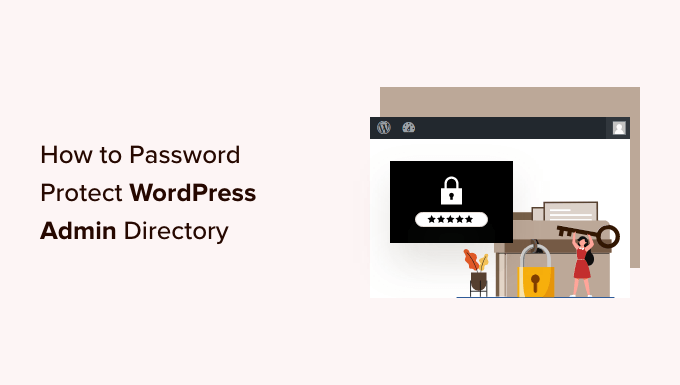
WordPress管理ディレクトリをパスワードで保護する理由
WordPress の管理ディレクトリをパスワードで保護することで、WordPress サイトの最も重要なエントリポイントにセキュリティのレイヤーを追加できます。
WordPressの管理ダッシュボードは、あなたのサイトの中心的なハブです。投稿やページの公開、テーマのカスタマイズ、WordPressプラグインのインストールなどを行う場所です。
ハッカーがあなたのサイトに侵入しようとする場合、ブルートフォースアタックを使ってwp-admin画面から行うことがよくあります。
強力なパスワードや ログイン試行の制限などのセキュリティ対策を行うことで、潜在的な攻撃からサイトを保護することができます。
さらに安全性を高めるために、wp-adminディレクトリをパスワードで保護することもできます。そうすれば、誰かがあなたの管理エリアにアクセスしようとしたとき、WordPressのログインページにたどり着く前にユーザー名とパスワードを入力する必要があります。
それでは、WordPressの管理ディレクトリをパスワードで保護する方法を順を追って見ていきましょう。
ほとんどのユーザーには最初の方法が推奨されており、以下のクイックリンクから使いたい方法に直接飛ぶことができる:
動画チュートリアル
もし、文章での説明がお望みなら、このまま読み進めてほしい。
方法1: ディレクトリプライバシーを使用してwp-adminをパスワードで保護する(推奨)
WordPressの管理ディレクトリをパスワードで保護する最も簡単な方法は、WordPressホスティングサービスのDirectory Privacyアプリを使用することです。
まず、ホスティングアカウントのダッシュボードにログインし、ウェブサイトのcPanelダッシュボードのファイルセクションにある「ディレクトリのプライバシー」オプションをクリックする必要があります。
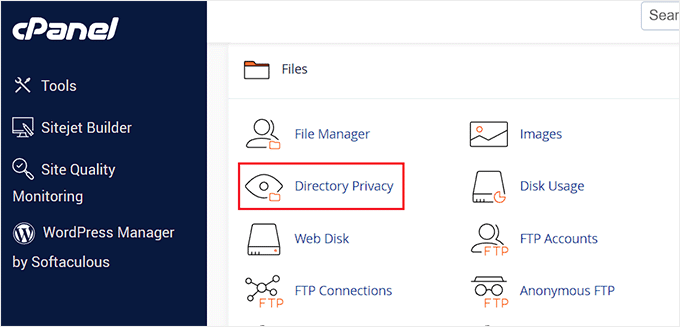
注: BluehostのようなcPanelを使用しているほとんどのホスティングサービスでは、同様の手順があります。ただし、ホスティングサービスによっては、ダッシュボードがスクリーンショットと若干異なる場合があります。
サーバー上のすべてのディレクトリを一覧表示する画面が表示されます。あなたのサイトのファイルを含むフォルダーを見つける必要があります。
ほとんどのサイトオーナーにとって、これは「public_html」フォルダーをクリックすることで見つけることができる。
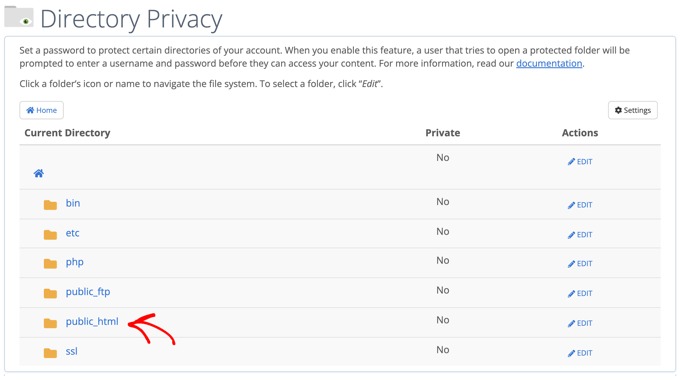
サーバーにインストールしたサイトファイルがすべて表示されます。
次に、あなたのサイトのドメイン名のフォルダーをクリックする必要があります。
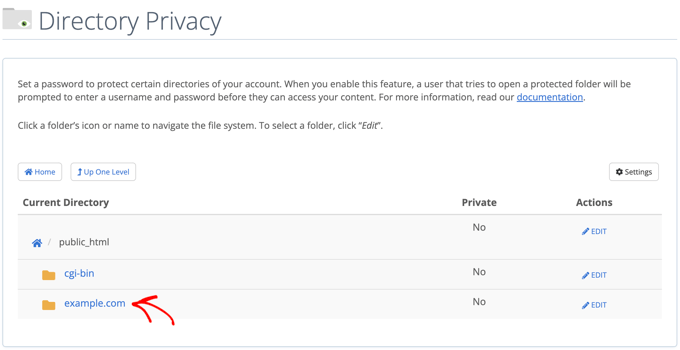
そのフォルダーの中にwp-adminフォルダーがあります。
フォルダー名をクリックする代わりに、そのフォルダーの横にある「編集」ボタンをクリックする必要があります。
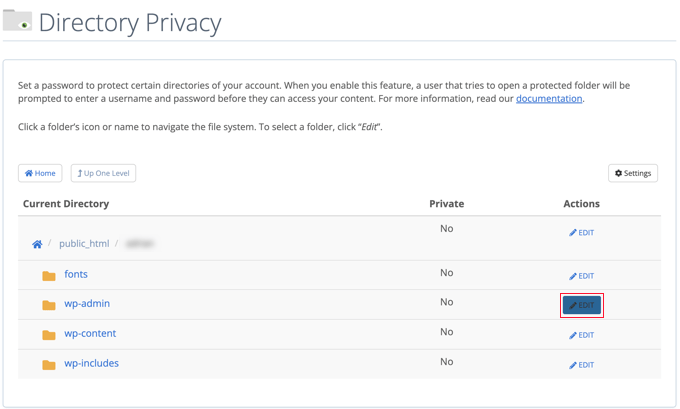
パスワード保護をオンにする画面が表示されます。
このディレクトリをパスワードで保護する」というボックスにチェックを入れるだけです。お好みで、ディレクトリに’Admin Area’のような名前をつけることもできます。
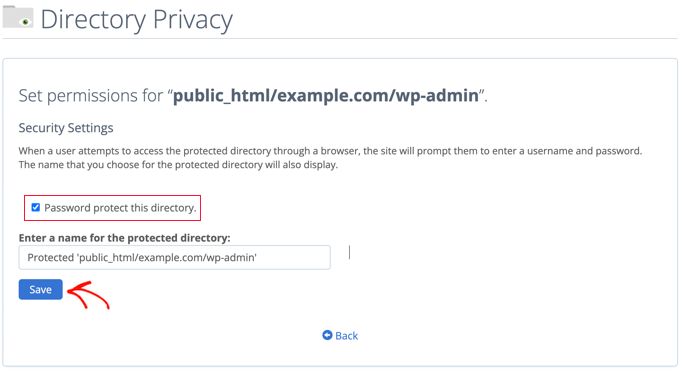
それが済んだら、『保存』ボタンをクリックしてください。
確認メッセージが表示されるページに移動します。

Go Back’ボタンをクリックすると、このディレクトリにアクセスできるユーザーを作成する画面になります。
ユーザー名とパスワードを入力し、パスワードを確認するよう求められます。ユーザー名とパスワードは、パスワード管理アプリなど安全な場所に控えておいてください。
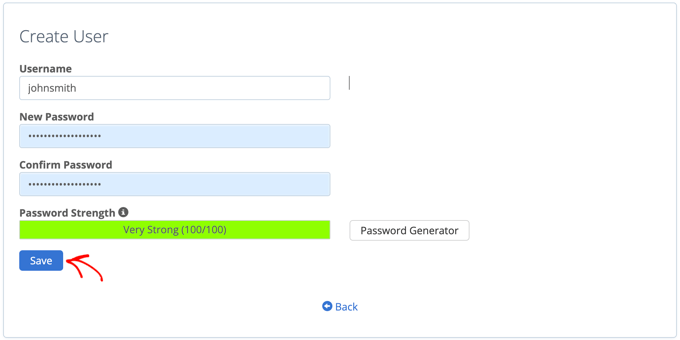
本当に〜してもよいですか?
これで、誰かがあなたの wp-admin ディレクトリにアクセスしようとすると、上記で作成したユーザー名とパスワードを入力するよう求められます。
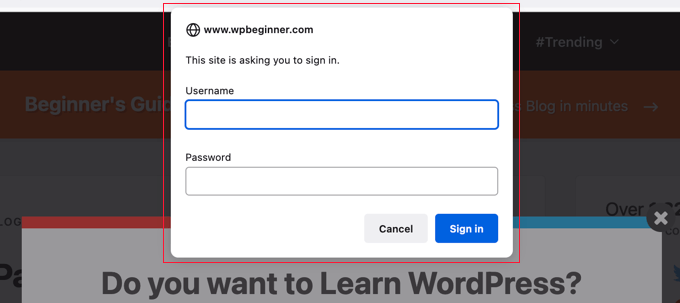
方法2:コードを使ってwp-adminをパスワードで保護する
WordPressの管理ディレクトリを手動でパスワード保護することもできます。そのためには、.htpasswdと .htaccessという2つのファイルを作成する必要があります。
注意:WordPressサイトにコードを追加することは危険です。小さなミスでも、サイトに大きなエラーを引き起こす可能性があります。この方法は上級ユーザーにのみお勧めします。
.htaccessファイルの作成
まず、お好みのテキストエディターを開き、新しいファイルの名前を.htaccessとします。
その後、以下のコード・スニペットをコピーしてファイルに追加する必要がある:
1 2 3 4 5 | AuthName "Admins Only"AuthUserFile /home/user/public_html/example.com/wp-admin/.htpasswdAuthGroupFile /dev/nullAuthType basicrequire user yourusername |
AuthUserFile’のパスを.htpasswdファイルをアップロードする場所に変更し、’yusername’をログイン中に使用するユーザー名に変更することを本当に〜してもよいですか?
終了したらファイルを保存することをお忘れなく。
.htpasswdファイルの作成
それができたら、.htpasswdファイルを作成する必要がある。
これを行うには、テキストエディターを開き、.htpasswdというファイルを作成します。このファイルには、ユーザー名とパスワードが暗号化された形式で記載されます。
暗号化されたパスワードを生成する最も簡単な方法は、htpasswdジェネレータを使うことです。
ユーザー名とパスワードを入力し、暗号化形式を選択して「.htpasswdファイルを作成」ボタンをクリックするだけです。
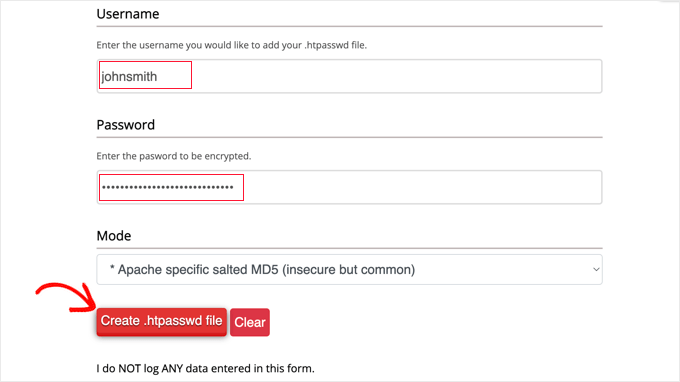
htpasswdジェネレータは、あなたが.htpasswdファイルに貼り付ける必要があるテキストの行を表示します。ファイルを保存したら、本当に〜してもよいですか?
wp-adminディレクトリへの.htaccessと.htpasswdのアップダー
最後のステップは、作成した両方のファイルをサイトのwp-adminフォルダにアップロードすることです。
FTPクライアントまたはホスティングサービスプロバイダーが提供するオンラインファイルマネージャツールを使用して、WordPressホスティングアカウントに接続する必要があります。詳細については、WordPressにファイルをアップロードするためのFTPの使用方法についての初心者ガイドを参照してください。
このチュートリアルでは、無料でMacでもWindowsでも使えるFileZillaを使います。
サイトに接続すると、左側のウィンドウにコンピューター上のファイル、右側にサイト上のファイルが表示されます。左側で、.htaccessと .htpasswdファイルを保存した場所にナビゲーションする必要があります。
次に、右側にある、保護したいサイトのwp-adminディレクトリに移動する必要があります。ほとんどのユーザーは、public_htmlフォルダーをダブルクリックし、次に自分のドメイン名のフォルダーをダブルクリックし、次にwp-adminフォルダーをダブルクリックする必要があります。
左側の2つのファイルを選択し、右クリックメニューから「アップロード」をクリックするか、左側のウィンドウにファイルをドラッグします。
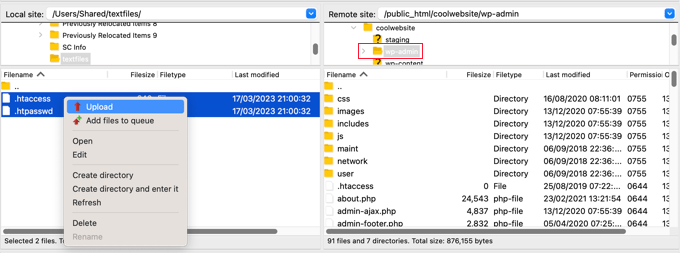
これで「wp-admin」ディレクトリがパスワードで保護されます。
wp-adminパスワード保護のトラブルシューティング
サーバーやサイトの設定によっては、WordPressのエラーに遭遇する可能性があります。これらのエラーは、.htaccessファイルに慎重にコードを追加することで修正できます。
注意:これはメインサイトフォルダにある.htaccessファイルで、’wp-admin’ フォルダーにアップロードしたものではありません。.htaccessが見つからない場合は、.htaccessが見つからない理由と見つける方法をご覧ください。
Ajaxが動作しないエラーの修正
最も一般的なエラーの1つは、サイトのフロントエンドでAjax機能が動作しなくなることです。ライブAjax検索や Ajaxお問い合わせフォームなど、Ajaxを必須とするWordPressプラグインを使用している場合、これらのプラグインが動作しなくなることに気づくでしょう。
これを修正するには、wp-adminフォルダーにある.htaccessファイルに以下のコードを追加するだけです:
1 2 3 4 5 | <Files admin-ajax.php> Order allow,deny Allow from all Satisfy any </Files> |
404エラーと多すぎるリダイレクトエラーの修正
他に遭遇する可能性のあるエラーは、404エラーと リダイレクトが多すぎるエラーです。
これらを修正する最も簡単な方法は、サイトディレクトリにあるメインの.htaccessファイルを開き、WordPressルールの前に以下のコード行を追加することです:
1 | ErrorDocument 401 default |
ボーナス:wp-adminセキュリティのためのベストWordPressガイド
この投稿が WordPress 管理 (wp-admin) ディレクトリをパスワードで保護する方法を学ぶのにお役に立てば幸いです。管理エリアをよりセキュアにするための、さらなるガイドもご覧ください:
- IPアドレスでWordPressの管理者アクセスを制限する方法
- WordPress管理エリアを守るための重要なヒント(更新)
- WordPressでカスタムログインURLを追加する方法(ステップバイステップ)
- WordPressでログイン試行を制限する方法と理由
- WordPressで2要素認証を追加する方法(無料方法)
- WordPressのログイン画面にセキュリティの質問を追加する方法
- WordPressでユーザーにパスワード変更を強制する方法 – Expire Password
- WordPressですべてのユーザーのパスワードをリセットする方法
If you liked this article, then please subscribe to our YouTube Channel for WordPress video tutorials. You can also find us on Twitter and Facebook.





Mrteesurez
Thanks. I found it helpful.
I want to ask if the methods are all offering the same level of security, I would prefer and recommend to stick to the first method as it seems easy and straight forward.
Or is there any one that is better than the other ??
WPBeginner Support
These are different methods to achieve the same result so it would depend on your preference for which one you would use.
Admin
Mark
Is there anyway for hackers to gain access to this password and even change it, like in phpMyAdmin ?
WPBeginner Support
They would need access to your hosting provider or site files for this guide.
Admin
Salman
I have changed my login URL using the “WPS Hide Login” plugin. Lets say the previous URL ended in wp-admin/ and the new URL ends in hidden/ now how can I password protect this new URL?
WPBeginner Support
It would depend on what method you are using and how you changed the URL, as long as there is a file/folder in the new location you should be able to select that folder or change the path on line 2 of the htaccess method
Admin
Jiří Vaněk
WPShide doesn’t create a new folder, I use that too. The wp-admin folder is still on the server and functional. So if you use WPSHide, secure the wp-admin folder exactly the same.
Jiří Vaněk
A good practice is also to rename the WordPress administration URL and choose a different administrator username than ‘admin.’ Changing the URL makes it harder for attackers to locate the administration, and not using ‘admin’ as the administrator reduces the risk of a successful brute force attack.
WPBeginner Support
Having a username other than admin is definitely recommended but for changing the wp-admin url is not always recommended as that can cause trouble with some plugins as well as make troubleshooting more difficult.
Admin
Jose
Ajax fix worked fine. Thanks a lot for this.
WPBeginner Support
Glad our article could help
Admin
Umer Yaseen
What if someone accesses our WordPress admin directory by entering mywebsite.com/wp-login.php instead of mywebsite.com/wp-admin. This method only protects wp-admin and not protects wp-login.php. So how it is useful?
WPBeginner Support
This would show the same prompt for users trying to log in using the wp-login.php
Admin
nadia
you are the best. thanks for thousand time like allways.
WPBeginner Support
Glad you’ve found our content helpful
Admin
Lordemmaculate
I want to do this but my server is Nginx not Apache so I can’t use .htaccess
WPBeginner Support
We’ll see if we can add a method for that type of server when we update this article
Admin
Rajah
The first method through cPanel worked like a charm. However, when I logout again from WP and login again it doesn’t ask again for the directory password. Is it meant to ask only once?
WPBeginner Support
Your cookies/cache will remember the login information. Normally the next time you start up your computer it will require you to log in again.
Admin
Webo
Very good, Thank you…
WPBeginner Support
You’re welcome
Admin
Izzy
The “Password Protect Directories” is not on my cPanel under “securitiy”, so I tried the manual way, but it doesn’t seem to work as it doesn’t ask for login when I open wp-admin…
WPBeginner Support
If you reach out to your hosting provider they should be able to assist and take a look if there’s any reason it wouldn’t be working.
Admin
Ahsan Ali
Thanks for your efforts!
I used cpanel method it works fine but the problem is that the password prompt appearing on every page of my website!
What i have to do so that it appear only at wp-admin page?
WPBeginner Support
It sounds like you may have password protected your public_html folder instead of the wp-admin folder. You would want to remove the current protection and attempt to set it up again
Admin